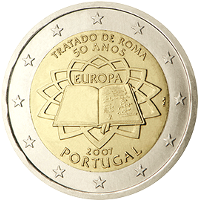 |
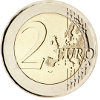 |
C o m m e m o r a t i v e
C o i n s |
||
| Portugal | |||||||
The edge embossing on the Portuguese 2‐Euro‐commemorative coins is : (The edge shows seven forts and five heraldic shields) |
until 2019 : INCM from 2020 : CASA DA MOEDA |
||||||
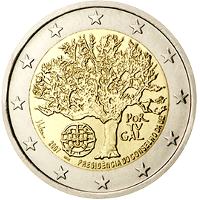 🔎
🔎 |
 |
Portugal | 02 Jul. 2007 | Portuguese Presidency of the Council of the European Union |
20001 20002 20005 |
1,300,000 |  |
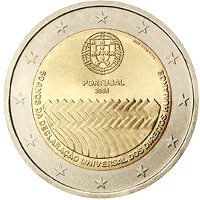 🔎
🔎 |
 |
Portugal | 15 Sep. 2008 | 60th anniversary of the Universal Declaration of Human Rights |
20001 20002 20005 |
1,035,000 |  |
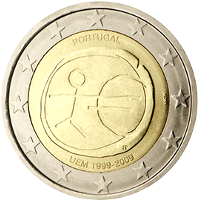 🔎
🔎 |
 |
Portugal | 05 Feb. 2009 | 10 years of Economic and Monetary Union (EMU) |
20001 20002 20005 |
1.285.000 |  |
National characteristics : Above is the name of the issuing country "Portugal", the acronym of the occasion of issue below is "UEM". The coin was minted without mint mark by the Portuguese mint Imprensa Nacional‐ Casa da Moeda S.A. in Lisbon. |
|||||||
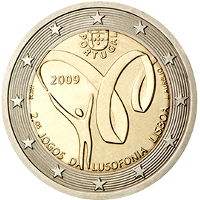 🔎
🔎 |
 |
Portugal | 09 Jun. 2009 | Lusophony Games 2009 |
20001 20002 20005 |
1,285,000 |  |
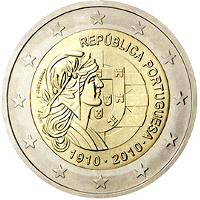 🔎
🔎 |
 |
Portugal | 07 Sep. 2010 | Centenary of the Portuguese Republic |
20001 20002 20005 |
1,035,000 |  |
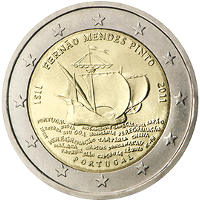 🔎
🔎 |
 |
Portugal | 15 Sep. 2011 | 500th birthday of Fernão Mendes Pinto |
20001 20002 20005 |
520,000 |  |
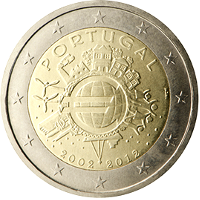 🔎
🔎 |
 |
Portugal | 24 Feb. 2012 | 10 years Euro‐Currency |
20001 20002 20005 |
520.000 |  |
National characteristics : At the top of the coin is the name of the issuing country "PORTUGAL". On the right is "INCM" the mint mark of the Portuguese mint Imprensa Nacional‐ Casa da Moeda S.A. in Lisbon. |
|||||||
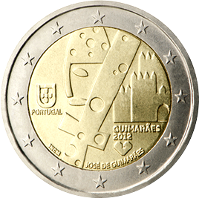 🔎
🔎 |
 |
Portugal | 21 Jun. 2012 | Guimaräes, European Capital of Culture 2012 |
20001 20002 20005 |
520,000 |  |
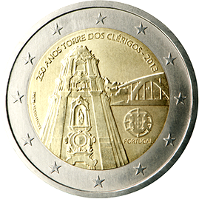 🔎
🔎 |
 |
Portugal | 20 Jun. 2013 | 250th anniversary of the Torre dos Clérigos, Porto |
20001 20002 20005 |
525,000 |  |
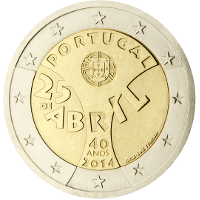 🔎
🔎 |
 |
Portugal | 23 Apr. 2014 | 40th anniversary of the Carnation Revolution |
20001 20002 20005 |
520,000 |  |
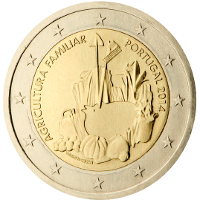 🔎
🔎 |
 |
Portugal | 31 Oct. 2014 | International Year of Family Farming |
20001 20002 20005 |
520,000 |  |
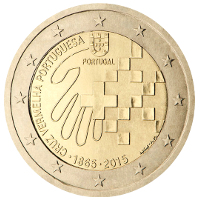 🔎
🔎 |
 |
Portugal | 25 Apr. 2015 | 150 years Portuguese Red Cross |
20001 20002 20005 |
520,000 |  |
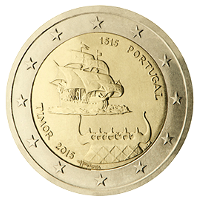 🔎
🔎 |
 |
Portugal | 15 Jul. 2015 | 500th anniversary of the first contact with Timor |
20001 20002 20005 |
520,000 |  |
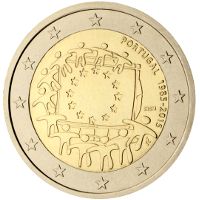 🔎
🔎 |
 |
Portugal | 30 Nov. 2015 | 30 years EU‐Flag |
20001 20002 20005 |
520.000 |  |
National characteristics : Above is the name of the issuing country "PORTUGAL", followed by the dates "1985‐2015". On the right is "INCM" the mint mark of the Portuguese mint Imprensa Nacional‐ Casa da Moeda S.A. in Lisbon. |
|||||||
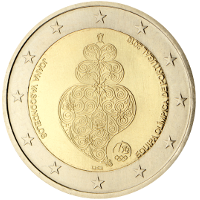 🔎
🔎 |
 |
Portugal | 03 May 2016 | Portuguese athletes participation in the Rio 2016 Summer Olympics |
20001 20002 20005 |
530,000 |  |
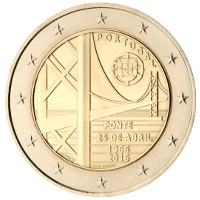 🔎
🔎 |
 |
Portugal | 19 Jul. 2016 | 50 years of the first bridge uniting the two riverbanks of the Tagus River |
20001 20002 20005 |
520,000 |  |
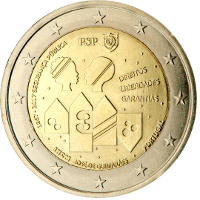 🔎
🔎 |
 |
Portugal | 13 Jul. 2017 | 150 years of Public Security (PSP) |
20001 20002 20005 |
520,000 |  |
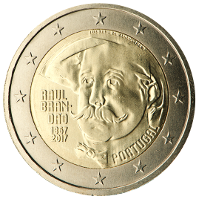 🔎
🔎 |
 |
Portugal | 21 Nov. 2017 | 150th birthday of Raul Brandäos |
20001 20002 20005 |
520,000 |  |
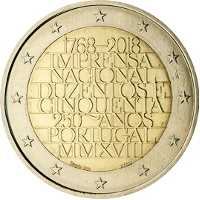 🔎
🔎 |
 |
Portugal | 22 May 2018 | 250 years since the foundation of the Imprensa Nacional |
20001 20002 20005 |
450,500 |  |
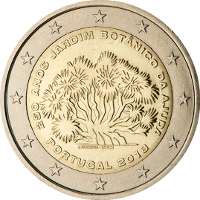 🔎
🔎 |
 |
Portugal | 25 Jul. 2018 | 250th anniversary of the foundation of Ajuda Botanical Garden |
20001 20002 20005 |
450,500 |  |
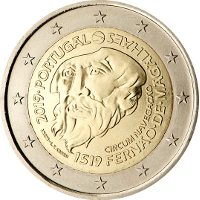 🔎
🔎 |
 |
Portugal | 08 May 2019 | 500th anniversary of Magellan's circumnavigation |
20001 20002 20005 |
520,000 |  |
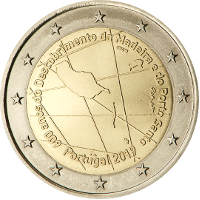 🔎
🔎 |
 |
Portugal | 06 Jun. 2019 | 600th anniversary of the discovery of Madeira and Porto Santos |
20001 20002 20005 |
520,000 |  |
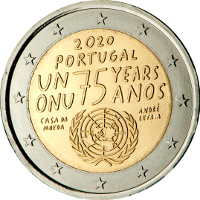 🔎
🔎 |
 |
Portugal | 01 Sep. 2020 | 730th anniversary of the University of Coimbra |
20001 20002 20005 |
360,000 |  |
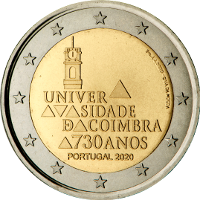 🔎
🔎 |
 |
Portugal | 07 Oct. 2020 | 75th anniversary of the United Nations |
20001 20002 20005 |
510,000 |  |
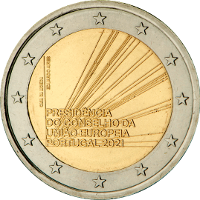 🔎
🔎 |
 |
Portugal | 04 Jan. 2021 | EU Presidency 2021 |
20001 20002 20005 |
510,000 |  |
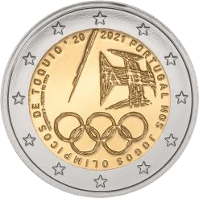 🔎
🔎 |
 |
Portugal | 18 May 2021 | Participation in the Summer Olympics in Tokyo |
20002 20003 20005 |
510,000 |  |
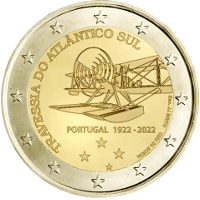 🔎
🔎 |
 |
Portugal | 30 Mar. 2022 | 100th anniversary of the first crossing of the South Atlantic by plane |
20003 20005 |
1,015,000 |  |
 Work in progress |
|||||||
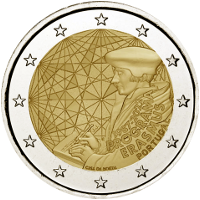 🔎
🔎 |
 |
Portugal | 01 Jul. 2022 | 35th anniversary of the Erasmus Program |
20003 20005 20009 |
512,000 |  |
National characteristics : The quarter circle at the bottom right has four lines; below the commemorative period, the occasion of issue is written in two lines "PROGRAMMA ERASMUS" (Erasmus programme in Portuguese), centred below it the issuing country "PORTUGAL". At the bottom the mint mark "CASA DA MOEDA" of the Portuguese mint Imprensa Nacional Casa da Moeda S.A. in Lisbon is shown. The coin is one of those with a more textured background. |
|||||||
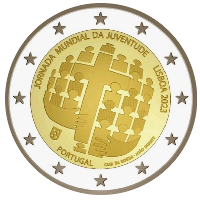 🔎
🔎 |
 |
Portugal | 19 Jul. 2023 | World Youth Day Lisbon 2023 |
20003 20005 20009 |
1,015,000 |  |
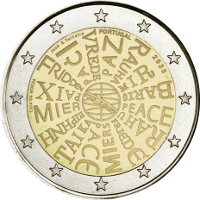 🔎
🔎 |
 |
Portugal | 15 Nov. 2023 | Peace |
20003 20005 |
515,000 |  |
 Work in progress |
|||||||
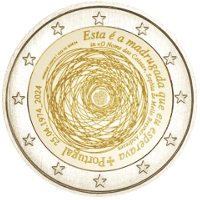
|
 |
Portugal | 22 Apr. 2024 | 50th anniversary of the Carnation Revolution of 25 April 1974 | 20003 | 515,000 |  |
 Work in progress |
|||||||
| References : | |||
| 20001 | Images taken with authorisation by the ECB ‐ Mail dated 20.Feb.2020 © "European Central Bank" |
20002 | Data mirrored from Wikipedia Page "2_euro_commemorative_coins" with friendly support of the guardians of that page. |
| 20003 | Images taken with authorisation by H....... Hamburg | 20004 | Coloured version of this Commemorative Coin in circulation EU‐legal‐technical specifications do not recongnise colour prints, but the EU is tolerate them, due to the facts that their numbers are very small and that they are sold in special packs and therefor are very unlikely to be used as currency. |
| 20005 |
enlarged Images taken with authorisation by Gerd Seyffert © "Gerd Seyffert 2021" |
20006 | Not Applicable |
| 20007 | Images taken by Münzen Kreuzberg © "Münzen Kreuzberg 2021" |
20008 | enlarged Images taken by Münzen Kreuzberg © "Münzen Kreuzberg 2021" |
| 20009 | Text with kind permission by Gerd Seyffert © "Gerd Seyffert 2023" |
20010 | Not Applicable |
 |
